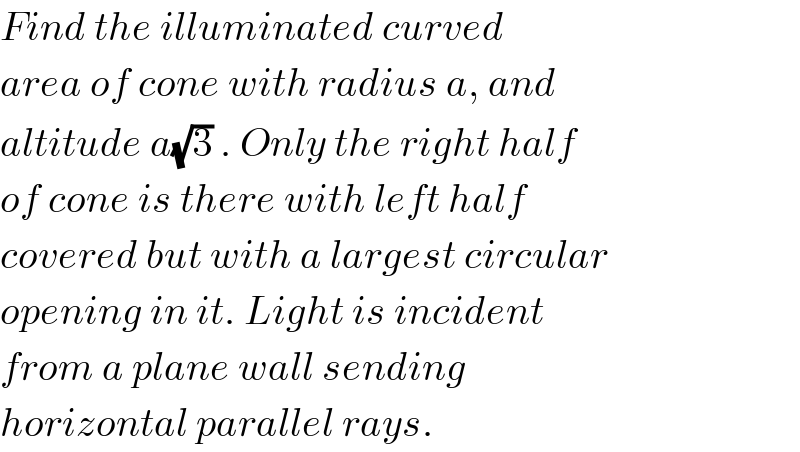
Question and Answers Forum
Question Number 73503 by ajfour last updated on 13/Nov/19

Commented by ajfour last updated on 13/Nov/19

Commented by mr W last updated on 14/Nov/19

Answered by mr W last updated on 13/Nov/19

Commented by mr W last updated on 14/Nov/19
![OD′=(√3)a OC=OD=2a C′D′=a sin θ OC′=(√(3a^2 +a^2 sin^2 θ))=a(√(3+sin^2 θ)) ∠C′OD′=ϕ tan ϕ=((sin θ)/(√3)) ⇒cos ϕ=((√3)/(√(3+sin^2 θ))) ⇒4cos^2 ϕ−3=((3 cos^2 θ)/(3+sin^2 θ)) r=(a/(√3)) OM=((2a)/(√3)) r^2 =OA′^2 +OM^2 −2×OA′×OM cos ϕ (a^2 /3)=OA′^2 +((4a^2 )/3)−2×OA′×((2a)/(√3)) cos ϕ OA′^2 −OA′×((4a)/(√3)) cos ϕ+a^2 =0 OA′=((2a cos ϕ)/(√3))−(√(((4a^2 cos^2 ϕ)/3)−a^2 )) OA′=(((2 cos ϕ−(√(4 cos^2 ϕ−3)))a)/(√3)) OB′=(((2 cos ϕ+(√(4 cos^2 ϕ−3)))a)/(√3)) ((OA)/(OA′))=((OC)/(OC′))=(2/(√(3+sin^2 θ))) ⇒OA=((2(2 cos ϕ−(√(4 cos^2 ϕ−3)))a)/(√(3(3+sin^2 θ)))) similarly ⇒OB=((2(2 cos ϕ+(√(4 cos^2 ϕ−3)))a)/(√(3(3+sin^2 θ)))) CD^(⌢) =a θ=2a φ ⇒φ=(θ/2) dA=(1/2)(OB^2 −OA^2 )dφ dA=2a^2 [(((2 cos ϕ+(√(4 cos^2 ϕ−3)))^2 −(2 cos ϕ−(√(4 cos^2 ϕ−3)))^2 )/(3(3+sin^2 θ)))]dφ dA=((8a^2 )/3)[((cos ϕ (√(4 cos^2 ϕ−3)))/(3+sin^2 θ))]dθ dA=((8a^2 cos θ dθ)/((3+sin^2 θ)^2 )) A=2×8a^2 ∫_0 ^(π/2) ((cos θ dθ)/((3+sin^2 θ)^2 )) A=16a^2 ∫_0 ^(π/2) ((d (sin θ))/((3+sin^2 θ)^2 )) A=16a^2 ∫_0 ^1 (dt/((3+t^2 )^2 )) A=((8a^2 )/3)[(1/(√3)) tan^(−1) (t/(√3))+(t/(t^2 +3))]_0 ^1 A=((8a^2 )/3)((1/(√3))×(π/6)+(1/4)) ⇒A=((2(2(√3)π+9)a^2 )/(27))≈1.4728a^2 Area of surface of semi−cone: (1/2)×(π/2)×(2a)^2 =π a^2 ((1.4728a^2 )/(πa^2 ))=0.47=47% i.e. 47% of the semi cone surface is lighted.](Q73609.png)
Commented by mr W last updated on 13/Nov/19

Commented by mr W last updated on 13/Nov/19

Commented by mr W last updated on 13/Nov/19

Commented by mr W last updated on 14/Nov/19

Commented by ajfour last updated on 14/Nov/19

Commented by mr W last updated on 14/Nov/19

